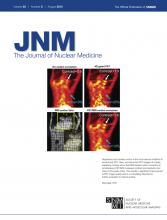REPLY: We appreciate the comments of Drs. Orsini, Guidoccio, Mazzari, and Mariani from Pisa. We would like to answer their questions point by point:
The patient population of our article (1) was totally independent from the population of the 2003 article by Palmedo et al. (2).
Although the 2003 paper was on a randomized prospective trial, our patients were evaluated only retrospectively through a questionnaire sent to the referring physicians—sometimes many years after the patients had passed away. In contrast to Palmedo et al. (2), we did not have data available after each therapy.
We included only patients for whom a complete questionnaire was returned by the referring physicians. Because we also contacted the practice via phone, the number of lost cases was low (∼10%).
Because we wished to keep the design of the questionnaire simple, no questions were asked about the duration of pain palliation.
Repeating of treatment at intervals of 2 mo was done on a regular basis to extend the antitumor effect and was not based on pain symptomatology or poor response to previous treatment.
The discussion mentioned that there was a certain bias concerning the fact that “only the fittest survive long enough to receive more treatments.”
Because we were expecting an antitumor effect, we also repeated therapy even if no significant bone pain palliation was observed.
All 22 patients of group C received at least 3 therapies. Eight patients had up to 4 therapies, 2 patients had up to 5 therapies, and 1 patient had 6 therapies with a mean interval of approximately 80 d.
The response of the PSA level was as follows: for group A, PSA decreased in 26.3%, did not change in 5.3%, and increased in 68.4%; for group B, PSA decreased in 15.8%, did not change in 15.8%, and increased in 68.4%; and for group C, PSA decreased in 27.3% and increased in 72.7%. These data refer to comparison of pre- and posttherapeutic (after end of treatment) PSA levels. Therefore, no thresholds were used.
As was pointed out, this was a study in palliatively treated patients for whom radionuclide therapy was the last therapeutic intervention. Thus, concomitant metastases may have been present, but these were not included in our questionnaire.
As was pointed out in our paper, all 60 patients were hormone-refractory and were no longer receiving any chemotherapy, hormone treatment, or other interventions, except for pain treatment.
In summary, this was a retrospective study in a palliative situation in which 188Re-HEDP was the only therapeutic option. The data were collected retrospectively over 8 y. In view of the workload of physicians in private practice, only a comprehensive questionnaire was developed. We hope that our answers will help the Pisa group to better evaluate our work.
Footnotes
Published online Jun. 1, 2012.
- © 2012 by the Society of Nuclear Medicine and Molecular Imaging, Inc.







